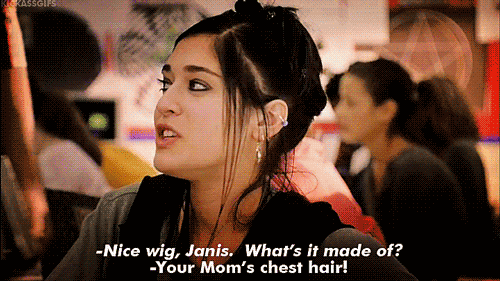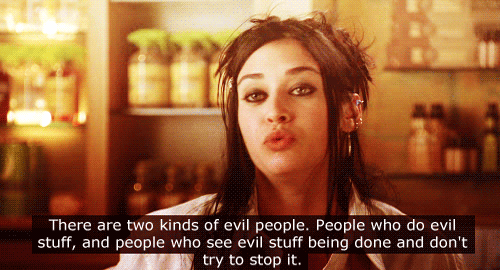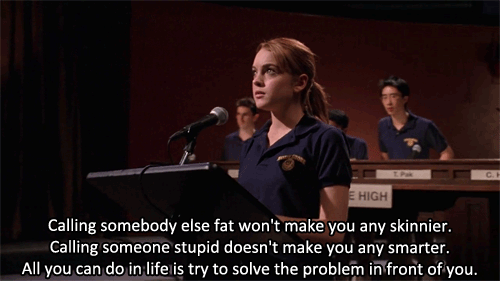The movie Mean Girls is about 16 year old Cady Heron, who goes from living in bush country in Africa being homeschooled by her parents to living in The United States of America going to a public high school for the first time. There she is confronted by a variety of stereotypical teen cliques from the ‘Sexually Active Band Geeks’ to ‘The Plastics,’ where she struggles to find out where she fits in until she is confronted by two outcasts (Janis and Damian) who hatch a plan to use Cady in order to infiltrate The Plastics to find out all the mean things they say about them, but what they didn’t see coming was Cady slowly turning into a plastic herself.
This film over exaggerates the stereotypes and representations of teenagers and teachers in high school. This is seen with the Plastics clique, as they are the most popular girls at school and they have perfect make-up, no acne or pimples, stylish clothes, rich parents, perfect bodies, perfect hair, and good looking boyfriends. This representation shows the younger audience that in order to be popular you must have all of these attributes, and if you don’t you can’t be popular. This can potentially affect teenage girls as if they do conform to this image of what teen girls should look, act and dress like conjured up by the media and enforced by society it’ll make them start hating themselves. Leading to them trying to hide their natural features through make-up if they think they aren’t pretty enough, getting plastic surgery to alter their body and enhance features, even lead to serious illnesses such as anorexia, bulimia and body dysmorphia. link to gif.  This representation of teenage girls affects society’s attitude and perception towards teenage girls as in mean girls they are seen as conceited, materialistic, bitchy and hate everyone who isn’t apart of their clique. As a teenage girl myself I can honestly say that in reality this simply isn’t true, in reality everybody sits with whoever they want to sit with at lunch and most people have more than one clique and alternate between those cliques to spend time with all the people they want to be friends with. Also in the real world, not all girls are all so easily-swayed to do things because someone else is doing it, for example if the most popular girl started wearing sandals because she likes them it doesn’t mean that I am going to follow her in her footsteps and wear the same shoes as her if I don’t like them. Whereas in mean girls when Regina has holes cut out of her singlet as revenge, all the other girls in school then see Regina wearing it and copy her style. (link to scene.) This representation of teenage girls being easily-swayed by woman they idolise is then perpetuated across the media, which leads to more people believing that all teenage girls are manipulable, gullible and credulous.
This representation of teenage girls affects society’s attitude and perception towards teenage girls as in mean girls they are seen as conceited, materialistic, bitchy and hate everyone who isn’t apart of their clique. As a teenage girl myself I can honestly say that in reality this simply isn’t true, in reality everybody sits with whoever they want to sit with at lunch and most people have more than one clique and alternate between those cliques to spend time with all the people they want to be friends with. Also in the real world, not all girls are all so easily-swayed to do things because someone else is doing it, for example if the most popular girl started wearing sandals because she likes them it doesn’t mean that I am going to follow her in her footsteps and wear the same shoes as her if I don’t like them. Whereas in mean girls when Regina has holes cut out of her singlet as revenge, all the other girls in school then see Regina wearing it and copy her style. (link to scene.) This representation of teenage girls being easily-swayed by woman they idolise is then perpetuated across the media, which leads to more people believing that all teenage girls are manipulable, gullible and credulous.
This film also covers the topic of body/self image as it appears the skinnier the plastics get, the more power they have to judge other girls in the school who aren’t like them. For example, this is seen when Regina is tricked into eating Kalteen Bars which causes her to gain weight rather than lose it, as Regina gains more and more weight she begins losing her power to judge and insult people until she is no longer considered the “Queen Bee” and no longer idolised at all within the school. One scene in particular that stood out to me when covering the topic of body image was when Cady and the Plastics went to Regina’s house. The Plastics who are all beautiful stand in front of the mirror and say things they don’t like about themselves. This scene is one of the few scenes which is actually true, the fact that teenage girls do look at themselves in the mirrors and point out flaws they want to fix in order for them to be closer to achieving perfection. This message is very effective in the representation that teenage girls are self-conscious, as most teenage girls can relate to looking in the mirror and pointing out all their flaws. Furthermore showing the ignorance of certain media outlets (magazines,etc.) as they choose to completely ignore this message of how self-conscious teenage girls actually are, and continue to perpetuate that the skinnier you are the more beautiful you are.
Regina George is the stereotypical ‘Queen Bee’ of North Shore High School and the leader of ‘The Plastics”. With her two followers (Gretchen Wieners and Karen Smith) constantly following her and obeying everything she says as seen in beginning of the jingle bell rock scene where she forces Gretchen to swap sides with Cady even though Gretchen doesn’t want to. Regina finds a way to be the centre of attention by bullying other girls and takes joy in ruling the school and her home. Regina George is the prime example of a stereotype as she is a tall, skinny, blonde haired, blue-eyed girl with her rich parents wrapped around her finger. She is what media and society’s ideal “perfect” teenage girl looks like, even though Rachel McAdams (the actress who played Regina George) was a full-grown 25 year old at the time. This then causes expectations of what your typical teenage girl should look like to get even higher than what they already are, causing teenage girls to feel more and more self-conscious about their appearance and being succumbed to bullying and peer pressure to change themselves. Although throughout the film Regina appears to also bully herself, as she constantly states throughout the film “I wanna lose 3 pounds” even though she is already skinny, this suggests that she has potential to develop one of several mental health problems such as anorexia, bulimia and body dysmorphia. Also in the scene where Karen, Gretchen and Regina are all standing in front of the mirror and even though they are all beautiful they only point out things that they don’t like about themselves, like that Regina can’t wear a halter top because she has “man shoulders” and that her “pores are huge.” The media then shows that they really do promote the idea of body image as it seems that you can’t be beautiful if you aren’t skinny, and to qualify as skinny you have to be a size 5 or less in dress stores leading Regina gaining the mental concept that she needs to lose weight.
Janis Ian is your stereotypical goth like outcast, who has a vengeance for her ex-best friend Regina George. Janis is snarky to everyone throughout the film and is not afraid to hide how she feels, she appears to be the only person who isn’t afraid to stand up to Regina. Janis used to be popular until her reputation was destroyed by a rumour that Regina made up saying Janis was a lesbian, leading to her dropping out of school for the rest of the year and when she returned, “all her hair was cut off, and she was totally weird.” Janis now willingly embraces the fact that she is an outsider with her new best friend Damien. Janis is another prime example of a stereotype as she is “the goth like outcast,” due to the fact she wears heavy dark eyeliner and dark coloured clothes only. She is not what the media would show as their ‘ideal’ teenage girl, as she wears darker colours making her appear more masculine than feminine, which is shown in the prom scene where Janis doesn’t wear a dress to prom but instead a matching purple suit with Damien. Janis is a strong, confident character throughout the film as I believe the bullying that she received when she was at middle school made her become tougher, as when another classmate says “Nice wig, Janis. What’s it made of?” she replies “Your mum’s chest hair.” Not letting his words get to her. As well as bestow some insightful wisdom as seen very rarely throughout the film such as “There are two kinds of evil people. People who do evil stuff, and people who see evil stuff being done and don’t do anything about it.” This quote I believe she based on her experience on being bullied referring to Regina as a person who does evil stuff as she made the rumour and spread it, and then referred to other students and teachers who saw this and didn’t do anything about it. This shows that the media only cares about the superficiality of teenage girls, not about who they are as a person and the obstacles they have overcome to be who they are today. Furthermore showing the audience that what you think is not as important as how you look. Hence, why the media talk about Regina George and the plastics, rather than about Janis Ian as she hasn’t conformed to society’s standards and expectations of how teenagers should look, act and dress. (GIF 1) (GIF 2) 

Cady Heron.

Cady Heron changes dramatically throughout the film. Cady started out the film going to her first day of school as the stereotypical new girl, she was very innocent and made sure to be very friendly to everyone. Cady wore baggy old clothes, with her hair tied up into a messy ponytail showing her looking like an average high school student and stood out from the crowd when she was walking into school, as she was the only one without a clique. Whereas on her second day of school, she befriends Janis and Damien. Who intern changes her views on people and manipulates her into hanging out with The Plastics so that they can find out the things they say about them. But as Cady hangs out with the Plastics more and more, her personality begins changing progressively into a replica of Regina’s leading to Cady becoming rude, nasty and back-stabbing all whilst ditching Janis and Damien. Also as Cady’s personality changes, her outfits change as well. Cady goes from wearing her an over-sized plaid shirt and baggy jeans, to wearing tight revealing clothes and more make-up that covers her facial features more as she becomes more obsessed with body-image and gossip. This change in her personality and style shows the audience how easy it can be for a teenage girl like Cady to be manipulated into changing herself, just so that she can fit in at school. It’s only at the very end of the film that Cady finds her true personality again, as she realises exactly how much she has changed and how much people hate her due to the effects that she has had on them. The media then shows Cady as easily-swayed by others and weak-minded, leading to parents and older viewers to think that this representation of new girls doing anything to feel like they belong and fit into new environments,even if it means having their personality besmirched is true. When in reality teenage girls are more strong-minded, and usually stick to being themselves. (Cady realising how she’s affected people.) 

